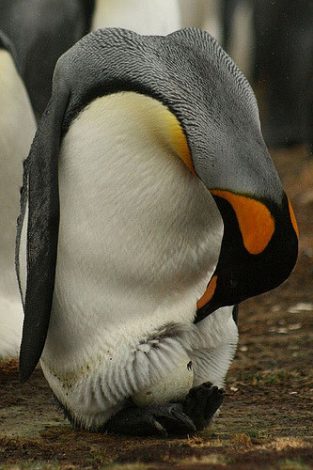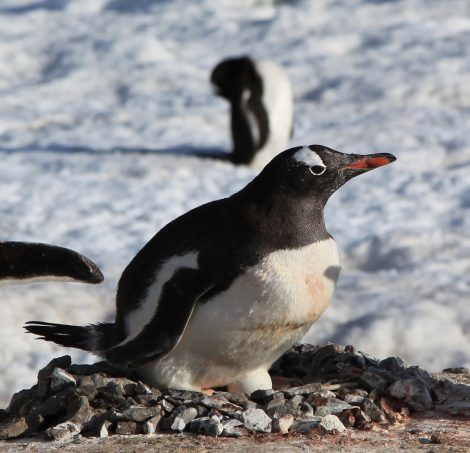Penguins are endemic to the southern hemisphere, the breeding season of penguins depend upon the species and the habitat. Every species of penguins lay one egg at a time except the emperor and the king penguins. The egg usually is kept on the feet of the males where the egg gets enough warmth by the brood patch present in the male parent.
The nesting preferences depend upon the species. The male penguins choose the nesting site before the breeding season. Females leave the egg to the males and move out for hunting. Except for emperor penguins, other species of penguins take turns to incubate the eggs.
The female emperor penguins hunt and return to the male to feed the chicks once the eggs hatch. Incubating the eggs can last up to several weeks where the male penguins tend to lose its weight while using the fat to give warmth to the eggs.
Not Every Penguin Lay Eggs in the Nest:
Penguins such as emperor penguins don’t build a nest; they survive on the icy surface. Penguins like Adelie penguins build a stone nest for comfortable staying during mating and incubation.
The male emperor penguins have to protect the chicks by only being on the harsh surface. The female emperor penguins handovers the egg carefully by the top of the feet to the males’ top of the feet; during this act, both the female and the male penguins take at most care not to drop the egg down.
Once the male gets the egg on its feet, it keeps the egg under the comfortable fold of skin which keeps the eggs warm until the female reaches the place after hunting.
During the entire session, the male emperor penguin has to rely on the fat present in the body, and they tend to lose several pounds during incubation. Parents of different species, take turns to babysit the eggs and help each other during the central period of life.
Male Parents Huddle:
When the male emperor penguins carry the eggs on their feet, they huddle along with the other fathers to get extra warmth to keep their eggs safely. Emperor penguins breed during May in the Antarctic winter whereas, other species of penguins breed in the summer.
The males huddle with other dedicated parents, waiting for their females to come home and take the responsibility. The female emperor penguins will be out for hunting to the ocean for around two months. When they return, the eggs will hatch and will be ready to eat the half-digested food that the mothers carry in the throat.
The time taken to incubate the eggs depends on the size of the egg.
Role of the Feet While Taking Care of the Eggs:
The feet of the penguins insulated with a hard plastic like coating. Every penguin’s legs set back of their body for their natural gait conduct. The feet allow the heat to pass out and help to maintain the body temperature.
Penguins’ feet do not get frozen in the icy Antarctic because the biological system of penguins manages the blood flow to the legs.
The arteries in the legs of the penguins regulate the blood flow according to the temperature. The foot is fed with adequate blood to ensure it above freezing point.
Thus, the eggs are kept safe under the body and upon the feet for the perfect incubating temperature in the freezing Antarctic.
The eggs are retained safe and intact under the body or also sometimes in between of the feet and folded skin act as the warmer to the eggs and protect them from the bitterly harsh climate.
The eggs almost tightly placed where there will be no effect of the severe cold when they are ready to hatch.
Usually, when the male penguins incubate the eggs, they tip up the toes to avoid direct cold penetrating the feet. They sit on their heel and balance the eggs. Male penguins break the shell of the egg when it tries to hatch to help the chick come out easily.
The male penguins keep the eggs safely on the feet even while hatching. Also, the strong and short tail help prevent the cold wind reaching the eggs from the back of the penguin’s body.
The male emperor penguins bow their head towards the egg when it is on the feet and keep watching the egg when it is ready to hatch. With the toes lifted, the penguins also avoid the egg from rolling down to the cold surface.
Not every penguin protects the egg by keeping on the feet. Penguins like Gentoo keep the egg on the dry surface of the Antarctic land and incubate sitting on the nest. Usually, Gentoo penguins make the stone nest to incubate the egg.
Conclusion:
Male penguins are good dads. They incubate their eggs dutifully and never give up waiting to see their chicks hatch out of the egg. Even though the male takes care of the eggs carefully, the shell of the eggs is hard when compared to other airborne birds.
The male penguins almost lose 45% of the body weight and wait for the break when the female penguins return from hunting. The chick tends to be under the parents’ body until they are two months old even after hatching.
Penguins in the tropical islands and Galapagos Islands have a different approach to the breeding and incubating season that is different from the emperor penguins’ behaviors towards their egg.
References:
https://www.livescience.com/27434-penguin-facts.html
https://seaworld.org/animals/all-about/penguins/reproduction/
https://www.kidzone.ws/animals/penguins/facts7.htm
https://animals.mom.me/long-emperor-penguins-care-young-10940.html
#eggs #faqs #penguins #where-do

